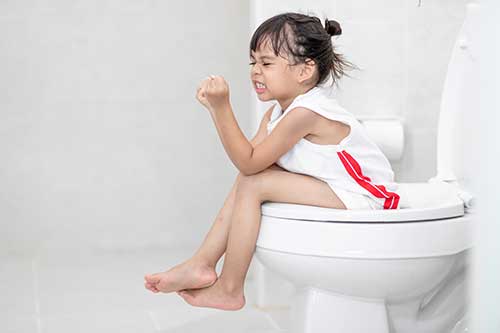Summer Stool Diaries
The good old summer time is synonymous with a lot of fun things children love – holidays, beaches, summer camps, sleepovers and eating the lion’s share of delicious juicy mangoes! It also comes with a very common childhood problem namely constipation. Let us try and understand what we can do to help our children with constipation.
What Is Constipation?
The definition of constipation revolves around 2 key aspects:
- “How often” your child poops.
- “How hard” the stools are.

Typically, a constipated child has fewer than 3 bowel movements per week. They struggle to pass the hard, dry stool. They have additional symptoms, namely abdominal pain, cramps, nausea, blood streaks in the stool and accidental soiling. They begin to exhibit holding behaviours, making grumpy faces, twisting and arching their backs and clenching the butt cheeks just to avoid having a painful bowel movement. The longer the stool stays in the bowel, the harder it becomes. This results in a vicious cycle.
What Causes Constipation?
- Several dietary and lifestyle causes are implicated in constipation. Low dietary fiber and inadequate fluid intake are the top 2 reasons for the same, in addition to a diet with dairy overload, processed foods, fatty foods, junk foods and soft drinks.
- Lack of exercise.
- Difficulties during toilet training, especially if prematurely attempted in a toddler who is still not ready for the same.
- Transitions during a child’s feeding journey – for instance, the switch over from breast milk to formula or from baby food to solids.
- Illness and stress.
- Withholding for reasons as simple as the fear of using a toilet out of home to a “difficult-to-handle” behavioural phase where holding back stools is a way of the child’s exhibition of taking control.
- Medical conditions associated with constipation including problems of the intestinal tract, anus, thyroid hormonal disturbances and certain nervous system problems.
How Can We Help Our Children?
- Establish a regular toilet routine. Make your child sit comfortably on the toilet seat for 10 minutes preferably after the morning milk/meal. You may attempt this twice a day during the initial phases of training.
- If you have a toddler at home, make potty training fun and stress-free. Amuse your child with bathroom-only books that come with funny pictures and bright illustrations or a potty training comic.
- Ensure that your child drinks enough fluids every day and is well-hydrated.
- Offer a healthy, fiber-rich diet replete with fruits, vegetables and whole grains. The super fiber foods are pears, berries, plums, kiwis, lentils, broccoli, whole grains, sweet potato, beets, bananas, citrus fruits, avocado, greens and dry fruits.
- Limit the intake of fast foods, fizzy drinks and caffeine.
- Reduce screen time and take them out to play and run to their heart’s content!
- Stool Softeners and Laxatives – Use only according to your caregiver’s recommendation.
When Do You Need to Call on a Paediatrician?
Schedule a consult with your child’s health care provider if your child has been constipated for over 2 weeks or exhibits warning signs such as a bloated abdomen, fever, repeated vomiting, refusal of feeds or blood in the stool.
All this said, here comes the good news! Constipation, in most cases, is a temporary stand-off and over 90% of children recover without any long-term impact on gut health.
We just need to understand how to keep things “moving” and help kids get into the habit of “going”!


